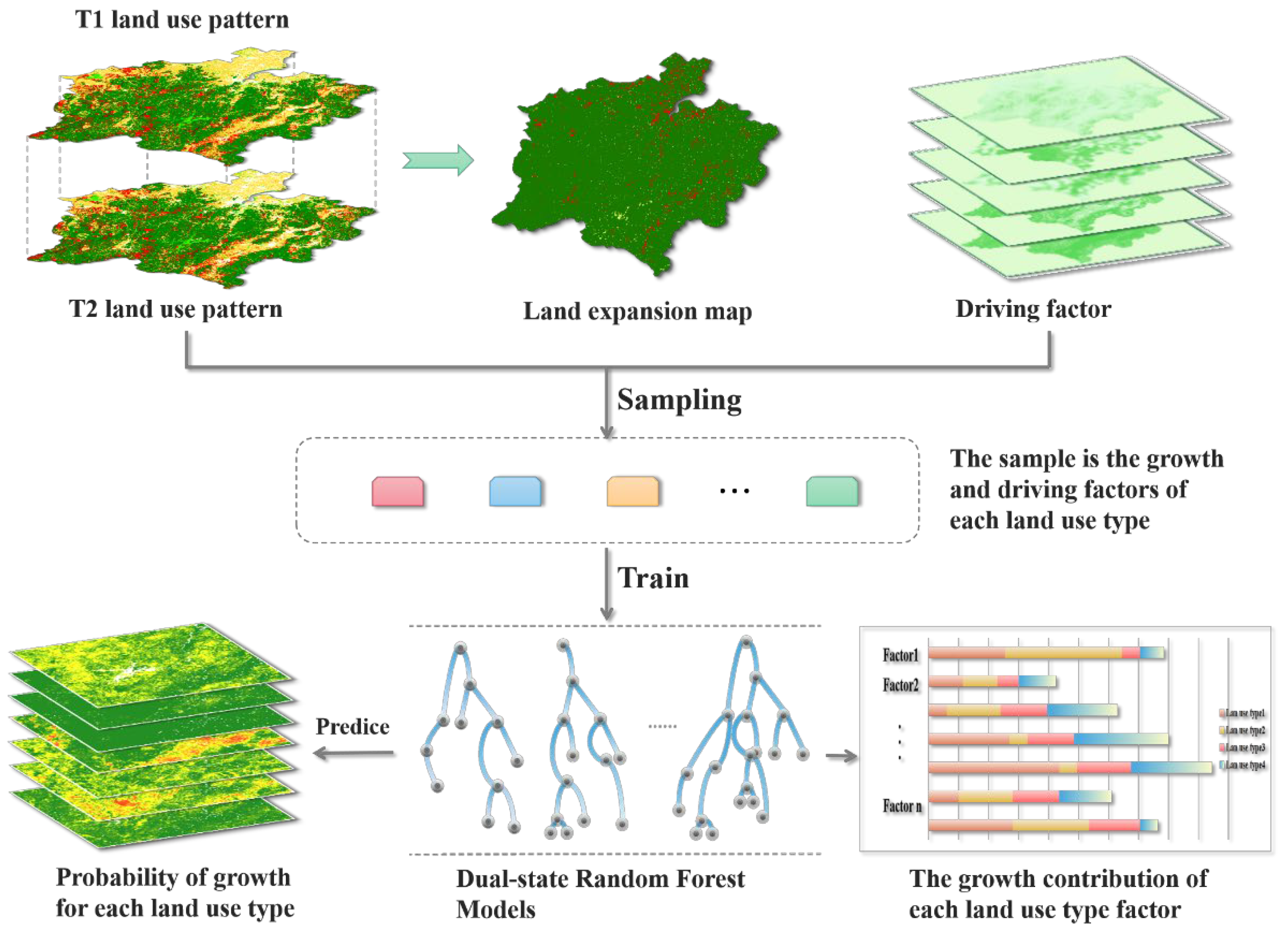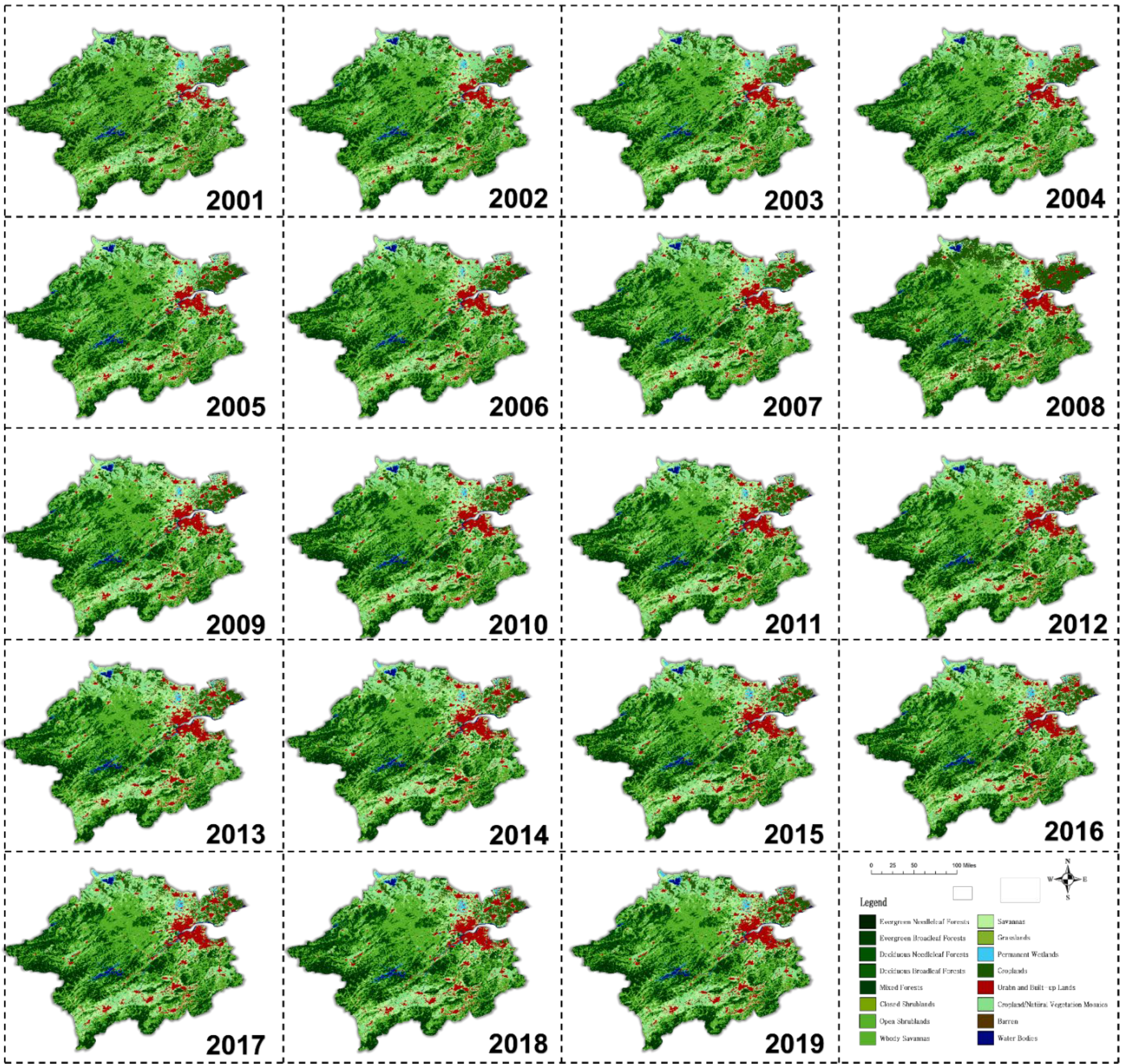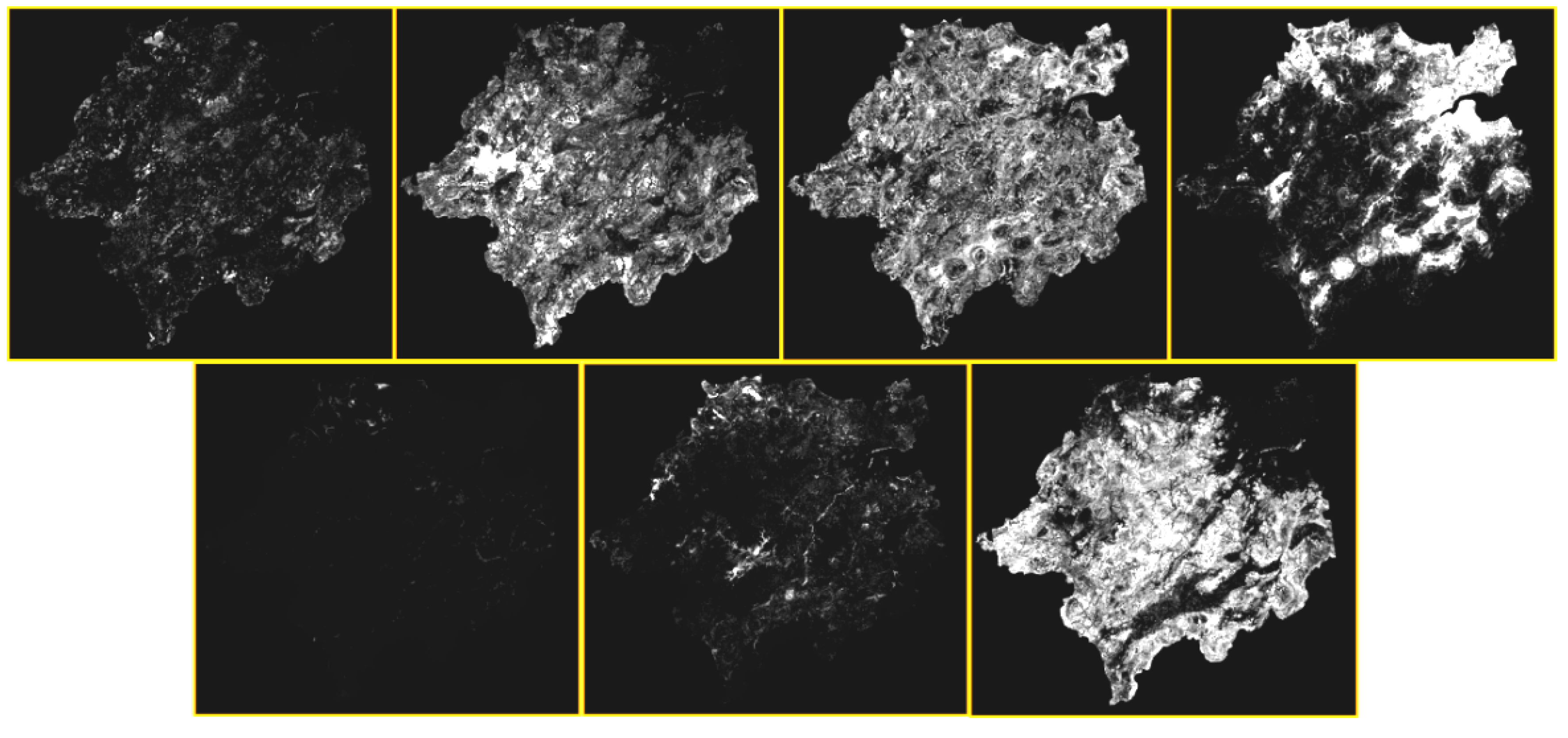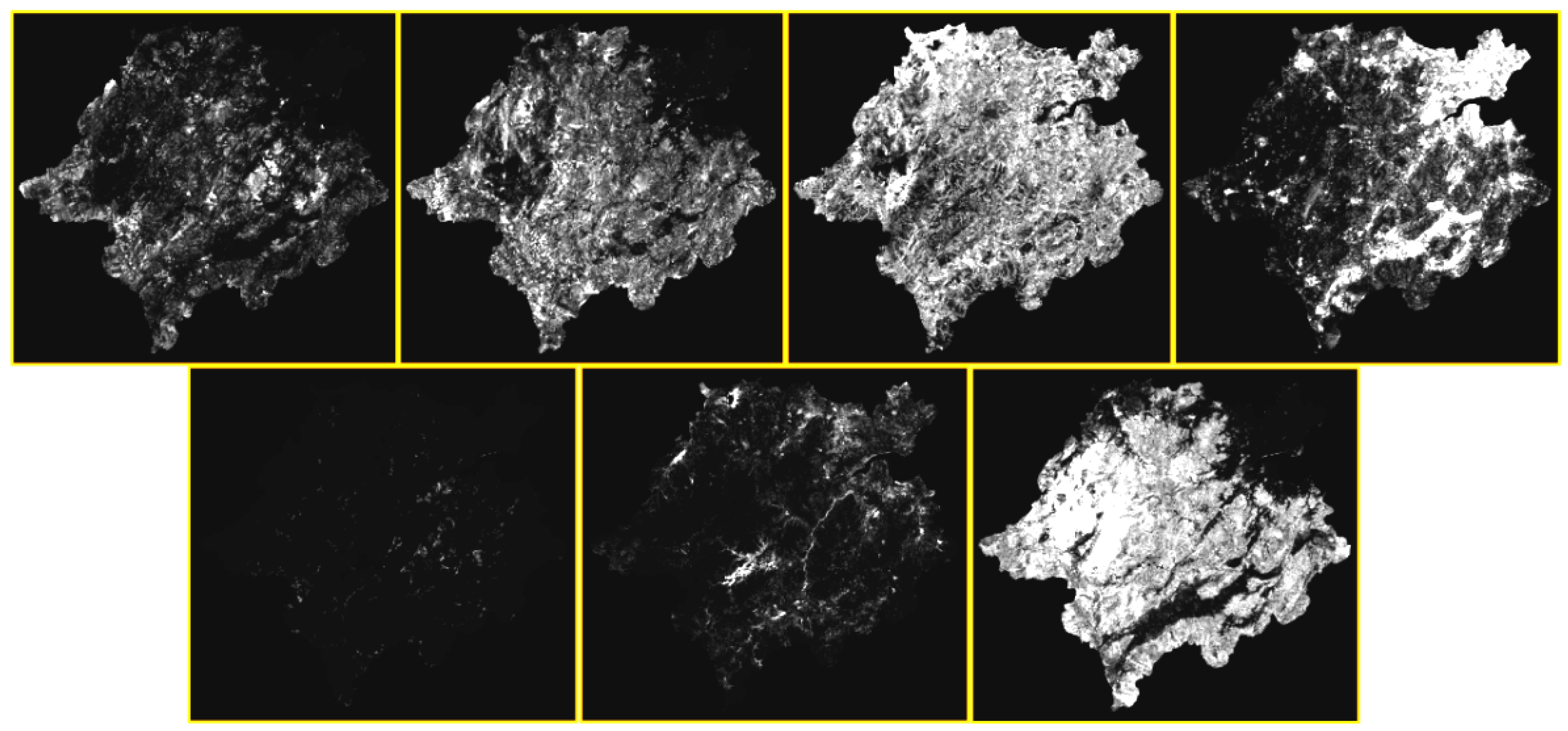Forecasting Urban Land Use Change Based on Cellular Automata and the PLUS Model
Abstract
:1. Introduction
2. Study Area and Data Sources
2.1. Overview of the Study Area
2.2. Data and Criteria
3. Methodology
3.1. LULC Data Processing
3.2. Introduction of the Patch-Generating Land Use Simulation (PLUS) Model
3.3. Selection of Driving Factors
3.3.1. Geomorphology and Geology
3.3.2. Climatic Settings
3.3.3. Economic Development
3.3.4. Industrialization Policies
4. Results
4.1. Land Use Interpretation
4.2. Urban Expansion Simulation Based on PLUS Model
4.3. Verification of PLUS Model
4.4. Application of PLUS Model for Prediction
5. Conclusions and Discussion
Author Contributions
Funding
Data Availability Statement
Conflicts of Interest
References
- UN Department of Economic and Social Affairs. World Urbanization Prospects: The 2018 Revision; United Nations: New York, NY, USA, 2018. [Google Scholar]
- Haaland, C.; van Den Bosch, C.K. Challenges and strategies for urban green-space planning in cities undergoing densification: A review. Urban For. Urban Green. 2015, 14, 760–771. [Google Scholar] [CrossRef]
- Rimal, B.; Zhang, L.; Keshtkar, H.; Wang, N.; Lin, Y. Monitoring and modeling of spatiotemporal urban expansion and land use/land-cover change using integrated Markov chain cellular automata model. ISPRS Int. J. Geo-Inf. 2017, 6, 288. [Google Scholar] [CrossRef] [Green Version]
- Saputra, M.H.; Lee, H.S. Prediction of land use and land cover changes for north sumatra, indonesia, using an artificial-neural-network-based cellular automaton. Sustainability 2019, 11, 3024. [Google Scholar] [CrossRef] [Green Version]
- Turner, B.; Moss, R.H.; Skole, D.L. Relating land use and global land-cover change. Glob. Change Rep. 1993, 5, 95. [Google Scholar]
- Cegielska, K.; Noszczyk, T.; Kukulska, A.; Szylar, M.; Hernik, J.; Dixon-Gough, R.; Jombach, S.; Valánszki, I.; Kovács, K.F. Land use and land cover changes in post-socialist countries: Some observations from Hungary and Poland. Land Use Policy 2018, 78, 1–18. [Google Scholar] [CrossRef]
- Kogo, B.K.; Kumar, L.; Koech, R. Analysis of spatio-temporal dynamics of land use and cover changes in Western Kenya. Geocarto Int. 2021, 36, 376–391. [Google Scholar] [CrossRef]
- Wu, R.; Li, Z.; Wang, S. The varying driving forces of urban land expansion in China: Insights from a spatial-temporal analysis. Sci. Total Environ. 2020, 766, 142591. [Google Scholar] [CrossRef]
- Zheng, W.; Li, X.; Yin, L.; Wang, Y. Spatiotemporal heterogeneity of urban air pollution in China based on spatial analysis. Rend. Lincei 2016, 27, 351–356. [Google Scholar] [CrossRef]
- Chen, X.; Yin, L.; Fan, Y.; Song, L.; Ji, T.; Liu, Y.; Tian, J.; Zheng, W. Temporal evolution characteristics of PM2.5 concentration based on continuous wavelet transform. Sci. Total Environ. 2020, 699, 134244. [Google Scholar] [CrossRef]
- Li, X.; Zheng, W.; Yin, L.; Yin, Z.; Xia, T. Influence of social-economic activities on air pollutants in Beijing, China. Open Geosci. 2017, 9, 314–321. [Google Scholar] [CrossRef] [Green Version]
- Gohain, K.J.; Mohammad, P.; Goswami, A. Assessing the impact of land use land cover changes on land surface temperature over Pune city, India. Quat. Int. 2021, 575, 259–269. [Google Scholar] [CrossRef]
- Zheng, W.; Li, X.; Yin, L.; Wang, Y. The retrieved urban LST in Beijing based on TM, HJ-1B and MODIS. Arab. J. Sci. Eng. 2016, 41, 2325–2332. [Google Scholar] [CrossRef]
- Li, X.; Zheng, W.; Lam, N.; Da, N.W.; Yin, Z. Impact of land use on urban water-logging disaster: A case study of beijing and new york cities. Environ. Eng. Manag. J. 2017, 16, 1211–1216. [Google Scholar]
- Lambin, E.F.; Turner, B.L.; Geist, H.J.; Agbola, S.B.; Angelsen, A.; Bruce, J.W.; Coomes, O.T.; Dirzo, R.; Fischer, G.; Folke, C.; et al. The causes of land use and land-cover change: Moving beyond the myths. Glob. Environ. Chang. 2001, 11, 261–269. [Google Scholar] [CrossRef]
- Li, X.; Yeh, A.G.O. Neural-network-based cellular automata for simulating multiple land use changes using GIS. Int. J. Geogr. Inf. Sci. 2002, 16, 323–343. [Google Scholar] [CrossRef]
- Chen, G.; Li, X.; Liu, X.; Chen, Y.; Liang, X.; Leng, J.; Xu, X.; Liao, W.; Qiu, Y.; Wu, Q.; et al. Global projections of future urban land expansion under shared socioeconomic pathways. Nat. Commun. 2020, 11, 537. [Google Scholar] [CrossRef] [Green Version]
- Clarke, K.C.; Gaydos, L.J. Loose-coupling a cellular automaton model and GIS: Long-term urban growth prediction for San Francisco and Washington/Baltimore. Int. J. Geogr. Inf. Sci. 1998, 12, 699–714. [Google Scholar] [CrossRef] [Green Version]
- Liu, L.; Li, Z.; Fu, X.; Liu, X.; Li, Z.; Zheng, W. Impact of Power on Uneven Development: Evaluating Built-Up Area Changes in Chengdu Based on NPP-VIIRS Images (2015–2019). Land 2022, 11, 489. [Google Scholar] [CrossRef]
- Cao, M.; Tang, G.; Shen, Q.; Wang, Y. A new discovery of transition rules for cellular automata by using cuckoo search algorithm. Int. J. Geogr. Inf. Sci. 2015, 29, 806–824. [Google Scholar] [CrossRef]
- Sohl, T.L.; Claggett, P.R. Clarity versus complexity: Land-use modeling as a practical tool for decision-makers. J. Environ. Manag. 2013, 129, 235–243. [Google Scholar] [CrossRef]
- Yang, J.; Gong, J.; Tang, W.; Liu, C. Patch-based cellular automata model of urban growth simulation: Integrating feedback between quantitative composition and spatial configuration. Comput. Environ. Urban Syst. 2020, 79, 101402. [Google Scholar] [CrossRef]
- Xu, Q.; Wang, Q.; Liu, J.; Liang, H. Simulation of land-use changes using the partitioned ANN-CA model and considering the influence of land-use change frequency. ISPRS Int. J. Geo-Inf. 2021, 10, 346. [Google Scholar] [CrossRef]
- Li, X.; Liu, X.P. Case-based cellular automaton for simulating urban development in a large complex region. Acta Geogr. Sin. 2007, 62, 1097–1109. [Google Scholar]
- Wu, D.; Wang, R.; Gao, S.; Ding, W.; Wang, W.; Ge, X.; Liu, J. Simulation and scenario analysis of arable land dynamics in Yellow River Delta. Trans. Chin. Soc. Agric. Eng. 2010, 26, 285–290. [Google Scholar]
- Liu, X.; Liang, X.; Li, X.; Xu, X.; Ou, J.; Chen, Y.; Pei, F. A future land use simulation model (FLUS) for simulating multiple land use scenarios by coupling human and natural effects. Landsc. Urban Plan. 2017, 168, 94–116. [Google Scholar] [CrossRef]
- Zhou, C.H.; Ou, Y.; Ma, T.; QIN, B. Theoretical perspectives of CA-based geographical system modeling. Prog. Geogr. 2009, 28, 833–838. [Google Scholar]
- White, R.; Engelen, G. Cellular automata and fractal urban form: A cellular modelling approach to the evolution of urban land-use patterns. Environ. Plan. A 1993, 25, 1175–1199. [Google Scholar] [CrossRef] [Green Version]
- Agyemang, F.S.; Silva, E.; Fox, S. Modelling and simulating ‘informal urbanization’: An integrated agent-based and cellular automata model of urban residential growth in Ghana. Environ. Plan. B Urban Anal. City Sci. 2022. [Google Scholar] [CrossRef]
- Zhou, Y.; Zhang, F.; Du, Z.; Ye, X.; Liu, R. Integrating cellular automata with the deep belief network for simulating urban growth. Sustainability 2017, 9, 1786. [Google Scholar] [CrossRef] [Green Version]
- Devendran, A.A.; Lakshmanan, G. Analysis and prediction of urban growth using neural-network-coupled agent-based cellular automata model for Chennai Metropolitan Area, Tamil Nadu, India. J. Indian Soc. Remote Sens. 2019, 47, 1515–1526. [Google Scholar] [CrossRef]
- Wu, X.; Liu, X.; Zhang, D.; Zhang, J.; He, J.; Xu, X. Simulating mixed land use change under multi-label concept by integrating a convolutional neural network and cellular automata: A case study of Huizhou, China. GISci. Remote Sens. 2022, 59, 609–632. [Google Scholar] [CrossRef]
- Zhang, X.; Zhou, J.; Song, W. Simulating urban sprawl in china based on the artificial neural network-cellular automata-Markov model. Sustainability 2020, 12, 4341. [Google Scholar] [CrossRef]
- Parvinnezhad, D.; Delavar, M.R.; Pijanowski, B.C.; Claramunt, C. Integration of adaptive neural fuzzy inference system and fuzzy rough set theory with support vector regression to urban growth modelling. Earth Sci. Inform. 2021, 14, 17–36. [Google Scholar] [CrossRef]
- Gharaibeh, A.; Shaamala, A.; Obeidat, R.; Al-Kofahi, S. Improving land use change modeling by integrating ANN with Cellular Automata-Markov Chain model. Heliyon 2020, 6, 05092. [Google Scholar] [CrossRef]
- Wang, R.; He, Q.; Zhang, L.; Wang, H. Coupling Cellular Automata and a Genetic Algorithm to Generate a Vibrant Urban Form—A Case Study of Wuhan, China. Int. J. Environ. Res. Public Health 2021, 18, 11013. [Google Scholar] [CrossRef]
- Momeni, E.; Antipova, A. Pattern-based calibration of cellular automata by genetic algorithm and Shannon relative entropy. Trans. GIS 2020, 24, 1447–1463. [Google Scholar] [CrossRef]
- Ma, S.; Liu, F.; Ma, C.; Ouyang, X. Integrating logistic regression with ant colony optimization for smart urban growth modelling. Front. Earth Sci. 2020, 14, 77–89. [Google Scholar] [CrossRef]
- Naghadehi, S.; Asadi, M.; Maleki, M.; Tavakkoli-Sabour, S.M.; Van Genderen, J.L.; Saleh, S.S. Prediction of Urban Area Expansion with Implementation of MLC, SAM and SVMs’ Classifiers Incorporating Artificial Neural Network Using Landsat Data. ISPRS Int. J. Geo-Inf. 2021, 10, 513. [Google Scholar] [CrossRef]
- Liang, X.; Guan, Q.; Clarke, K.C.; Liu, S.; Wang, B.; Yao, Y. Understanding the drivers of sustainable land expansion using a patch-generating land use simulation (PLUS) model: A case study in Wuhan, China. Comput. Environ. Urban Syst. 2021, 85, 101569. [Google Scholar] [CrossRef]
- Gu, C.; Hu, L.; Zhang, X.; Wang, X.; Guo, J. Climate change and urbanization in the Yangtze River Delta. Habitat Int. 2011, 35, 544–552. [Google Scholar] [CrossRef]
- Zhou, L.; Dang, X.; Sun, Q.; Wang, S. Multi-scenario simulation of urban land change in Shanghai by random forest and CA-Markov model. Sustain. Cities Soc. 2020, 55, 102045. [Google Scholar] [CrossRef]
- Verburg, P.H.; Overmars, K.P. Combining top-down and bottom-up dynamics in land use modeling: Exploring the future of abandoned farmlands in Europe with the Dyna-CLUE model. Landsc. Ecol. 2009, 24, 1167–1181. [Google Scholar] [CrossRef]
- Tong, D.; Chu, J.; Han, Q.; Liu, X. How Land Finance Drives Urban Expansion under Fiscal Pressure: Evidence from Chinese Cities. Land 2022, 11, 253. [Google Scholar] [CrossRef]
- Salem, M.; Bose, A.; Bashir, B.; Basak, D.; Roy, S.; Chowdhury, I.R.; Alsalman, A.; Tsurusaki, N. Urban Expansion Simulation Based on Various Driving Factors Using a Logistic Regression Model: Delhi as a Case Study. Sustainability 2021, 13, 10805. [Google Scholar] [CrossRef]
- Gantumur, B.; Wu, F.; Vandansambuu, B.; Tsegmid, B.; Dalaibaatar, E.; Zhao, Y. Spatiotemporal dynamics of urban expansion and its simulation using CA-ANN model in Ulaanbaatar, Mongolia. Geocarto Int. 2022, 37, 494–509. [Google Scholar] [CrossRef]
- Pijanowski, B.C.; Tayyebi, A.; Delavar, M.R.; Yazdanpanah, M.J. Urban expansion simulation using geospatial information system and artificial neural networks. Int. J. Environ. Res. 2009, 3, 493–502. [Google Scholar]











| Data | Criteria | Year | Description | Source | Data Format |
|---|---|---|---|---|---|
| Driving factor | GDP | 2005 2010 2015 2018 | 30 arc-rec spatial resolution | Institute of Remote Sensing and Digital Earth, Chinese Academy of Sciences (http://www.radi.cas.cn/index_65411.html (accessed on 10 October 2021)) | GeoTIFF |
| Subway | |||||
| EDM | |||||
| Elevation | |||||
| Highway | |||||
| River | |||||
| Slope | |||||
| Population | |||||
| Soil | |||||
| School | |||||
| Hospital | |||||
| LULC map | LULC | 2001~2019 | 500 arc-rec spatial resolution | United States Geological Survey (USGS) (https://earthexplorer.usgs.gov/ (accessed on 10 November 2021)) | GeoTIFF |
| LULC map | LULC | 2005 2010 2015 2018 | 30 arc-rec spatial resolution | United States Geological Survey (USGS) (https://earthexplorer.usgs.gov/ (accessed on 10 November 2021)) | GeoTIFF |
| Administrative map | Hangzhou | 2021 | A satellite image from Landsat, USGS and LAPAN | Ministry of Environment and Forestry, Indonesia (http://webgis.dephut.go.id:8080/kemenhut/index.php/id/fitur/unduhan (accessed on 10 November 2021) , https://earthexplorer.usgs.gov/ (accessed on 10 November 2021)) | KML |
| Shaoxing | |||||
| Huzhou | |||||
| Jiaxing | |||||
| Jinhua | |||||
| Xuancheng | |||||
| Huangshan | |||||
| Quzhou |
| Year | Kappa Coefficient (%) | User’s Accuracy (%) | ||||||
|---|---|---|---|---|---|---|---|---|
| Grass | Deciduous Forest | Cultivated Field | Urban Land | Bare Land | Waters | Evergreen Forest | ||
| 2005–2010 | 0.956 | 0.988 | 0.976 | 0.965 | 0.842 | 0.954 | 0.988 | 0.988 |
| 2010–2015 | 0.918 | 0.933 | 0.934 | 0.929 | 0.854 | 0.910 | 0.925 | 0.971 |
| 2015–2018 | 0.923 | 0.944 | 0.901 | 0.936 | 0.891 | 0.792 | 0.930 | 0.976 |
| Year | Grass | Deciduous Forest | Cultivated Field | Urban Land | Bare Land | Waters | Evergreen Forest |
|---|---|---|---|---|---|---|---|
| 2005–2010 | 2,620,709 | 8,157,319 | 23,216,915 | 4,817,324 | 15,459 | 2,151,630 | 44,151,632 |
| Real (2010) | 2,809,602 | 8,248,160 | 23,216,938 | 4,817,326 | 20,945 | 2,349,566 | 43,688,758 |
| 2010–2015 | 2,784,092 | 8,278,020 | 22,533,997 | 5,478,163 | 10,133 | 2,338,896 | 43,727,994 |
| Real (2015) | 2,784,850 | 8,545,279 | 22,536,173 | 5,609,103 | 22,292 | 2,340,847 | 43,312,322 |
| 2015–2018 | 2,668,851 | 8,566,745 | 22,075,873 | 5,916,046 | 19,137 | 2,327,583 | 43,576,631 |
| Real (2018) | 2,820,751 | 8,127,297 | 22,080,545 | 6,189,235 | 19,141 | 2,328,292 | 43,580,324 |
| Year | Grass | Deciduous Forest | Cultivated Field | Urban Land | Bare Land | Waters | Evergreen Forest |
|---|---|---|---|---|---|---|---|
| 2024 | 2,888,345 | 7,412,612 | 21,330,385 | 7,156,186 | 14,780 | 2,305,684 | 44,025,773 |
| 2027 | 2,919,596 | 7,107,580 | 21,029,018 | 7,560,284 | 13,299 | 2,295,743 | 44,208,246 |
| 2030 | 2,949,129 | 6,832,732 | 20,767,392 | 7,919,104 | 12,149 | 2,286,461 | 44,366,799 |
Publisher’s Note: MDPI stays neutral with regard to jurisdictional claims in published maps and institutional affiliations. |
© 2022 by the authors. Licensee MDPI, Basel, Switzerland. This article is an open access article distributed under the terms and conditions of the Creative Commons Attribution (CC BY) license (https://creativecommons.org/licenses/by/4.0/).
Share and Cite
Xu, L.; Liu, X.; Tong, D.; Liu, Z.; Yin, L.; Zheng, W. Forecasting Urban Land Use Change Based on Cellular Automata and the PLUS Model. Land 2022, 11, 652. https://doi.org/10.3390/land11050652
Xu L, Liu X, Tong D, Liu Z, Yin L, Zheng W. Forecasting Urban Land Use Change Based on Cellular Automata and the PLUS Model. Land. 2022; 11(5):652. https://doi.org/10.3390/land11050652
Chicago/Turabian StyleXu, Linfeng, Xuan Liu, De Tong, Zhixin Liu, Lirong Yin, and Wenfeng Zheng. 2022. "Forecasting Urban Land Use Change Based on Cellular Automata and the PLUS Model" Land 11, no. 5: 652. https://doi.org/10.3390/land11050652
APA StyleXu, L., Liu, X., Tong, D., Liu, Z., Yin, L., & Zheng, W. (2022). Forecasting Urban Land Use Change Based on Cellular Automata and the PLUS Model. Land, 11(5), 652. https://doi.org/10.3390/land11050652









